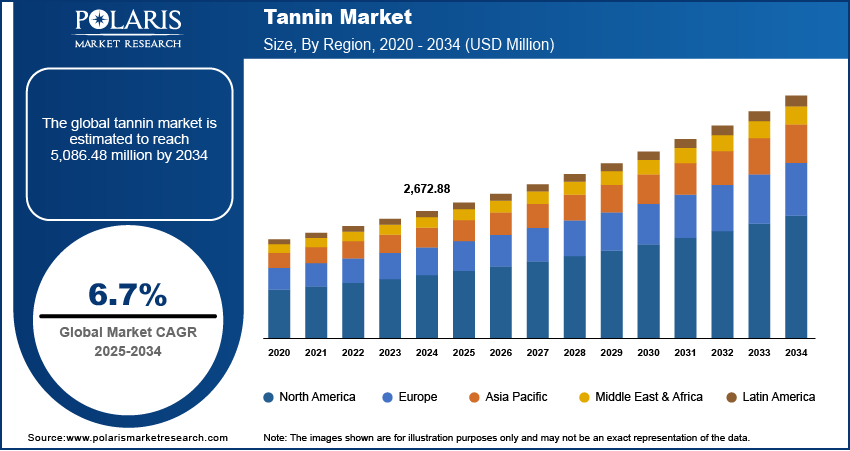Tannin Market Expected to Reach USD 5,086.48 Million by 2034, Growing at a CAGR of 6.7%

Global Tannin Market size and share is currently valued at USD 2,672.88 million in 2024 and is anticipated to generate an estimated revenue of USD 5,086.48 million by 2034, according to the latest study by Polaris Market Research. Besides, the report notes that the market exhibits a robust 6.7% Compound Annual Growth Rate (CAGR) over the forecasted timeframe, 2025 – 2034.
Key Market Trends & Insights
- Rising Popularity of Plant-Based Additives
Increasing consumer preference for clean-label and natural ingredients is driving demand for tannins in food, beverages, and nutraceuticals. - Surge in Wine Production and Consumption
Tannins are essential in wine aging and flavor development, boosting their demand in the global wine industry, especially in Europe and the Americas. - Expansion in Pharmaceutical and Healthcare Uses
With proven anti-inflammatory and antioxidant properties, tannins are being studied and adopted for herbal medicine formulations and nutraceutical products. - Eco-Friendly Leather Tanning Practices
The leather industry is gradually shifting from synthetic tanning agents to plant-based tannins, especially in light of environmental regulations. - Increased Use in Animal Feed
Tannins are used as natural growth promoters and antimicrobial agents in livestock nutrition, reducing reliance on synthetic additives.
Market Size & Forecast
- Market size value in 2025 – USD 2,847.51 million
- Revenue forecast in 2034 – USD 5,086.48 million
- CAGR – 6.7% from 2025 – 2034
Market Overview
The tannin market is witnessing consistent growth, fueled by its expanding applications in industries such as food & beverages, leather tanning, wine production, pharmaceuticals, and animal feed. Tannins are naturally occurring polyphenolic compounds found in various plants, notably in bark, leaves, and fruits. Their antioxidant, antimicrobial, and astringent properties make them highly valuable in multiple commercial applications. With growing interest in natural and plant-based ingredients, tannins are gaining significant traction as eco-friendly alternatives across several industries.
Request a Free Sample Research PDF:
https://www.polarismarketresearch.com/industry-analysis/tannin-market/request-for-sample
Key Market Growth Drivers
- Growing Demand for Natural and Sustainable Ingredients
As industries move toward green chemistry and sustainability, tannins offer a viable natural alternative to synthetic chemicals. - Boom in Wine Industry
Global expansion of vineyards and increasing consumer interest in premium and aged wines are directly contributing to higher tannin consumption. - Health Benefits and Functional Applications
The demand for polyphenol-rich compounds like tannins is rising due to their potential health benefits, including gut health, cardiovascular support, and anti-aging effects. - Environmental Regulations Driving Change in Leather Industry
Tighter environmental norms are prompting tanneries to adopt vegetable tanning methods, creating more demand for tannin-rich plant extracts.
Market Challenges
- Fluctuation in Raw Material Supply
The availability of high tannin content plants depends on seasonal factors, geographical limitations, and deforestation concerns, affecting consistency in supply. - Limited Awareness in Emerging Markets
While developed markets are adopting tannins rapidly, lack of awareness and processing capabilities in emerging economies hinder market growth. - Complex and Costly Extraction Processes
Extracting tannins in pure form can be technically complex and cost-intensive, especially when high purity is required for pharmaceutical or nutraceutical applications. - Competition from Synthetic and Alternative Additives
In some industries, synthetic substitutes may offer lower prices or greater processing convenience, posing competition to tannin adoption.






